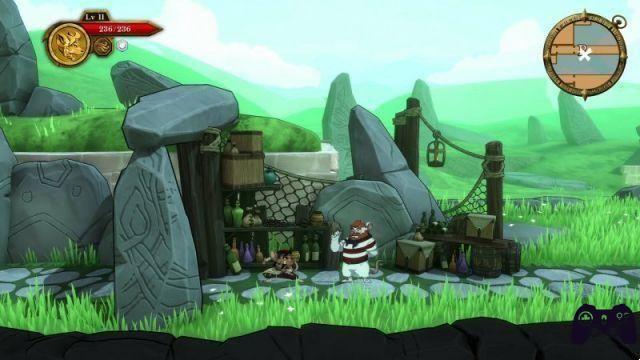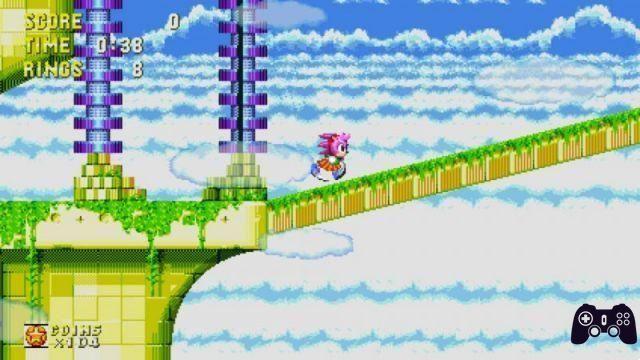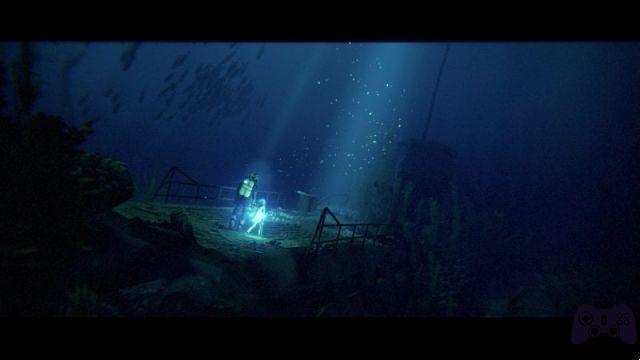When I think back to my first contact with Ghost of Tsushima I am reminded of the various posts and tweets from the development team sucker Punch, which illustrated the great enthusiasm that the trips to the real Tsushima had aroused in everyone working on the project. The Japanese historical legacy, by now we know, is a thriving ground to draw on endlessly thanks to legends, myths, epochal figures and entire families with a flourishing past. We have seen it over and over again in any creative expression of the folklore of the Rising Sun, yet Sucker Punch's approach, from the very first moments, seemed very particular, as if eager to bring a cross-section of Japan that was as close as possible to all the elements so you love it without relying on the "fantastic".
Since its inception Ghost of Tsushima has shown itself exactly what it set out to be: the most beautiful love letter to Japanese culture in recent years. From the very explicit references to Akira Kurosawa to oriental poetics, arriving at religiosity and symbolism, there really isn't nothing out of place when looking at the aesthetic representation or Japan's cultural proposal. A fair reward that I want to attribute immediately to the great efforts of the team, palpable in every single moment of my experience, regardless of what the overall verdict or the memory that the general public will have of the work. .
Enemies from the sea, winds of change, family destiny
Starting with what we all know, Sucker Punch's work is based on representation of the first Mongol invasion, one of the most particular events in Eastern history due to the cultural / war clash with which the two civilizations have had to deal. The opening of the first minutes of the title is in fact the clear proof of this, showing us a samurai who welcomes the Mongols by challenging them to a duel of honor, promptly rejected by the enemies in favor of a fearless execution in pure barbarian style. From this single event we understand how much the battle of Tsushima (and the subsequent phases of the Mongol war) were a turning point in the Japanese conception of war, played by the protagonist Jin sakai in Ghost of Tsushima.

Jin, samurai of a noble family of Tsushima, in fact escapes death by a whisker and wakes up with the entire island now in the hands of the invaders, who adopt brutal tactics ranging from torturing the innocent to explosive bombs, techniques never seen before. by the Japanese. From the first minutes one might think that Ghost of Tsushima is the story of a lone samurai who, remaining faithful to his code, drives out the Mongols with only the values of the way of the sword. Instead it is not so and indeed the idea of Sucker Punch was that of find a plot that could communicate the necessary end of an era of traditions wars that have defined generations after generations, without however disrespecting the immortal ideal of the samurai. It will be up to you to discover the complications of this choice.
In Jin's growth and his new revived vision we find the Ghost of Tsushima: not a samurai, not a criminal, just a gray figure who defends his people at all costs, somehow embodying the spirit of vengeance of an entire people. Sucker Punch develops this path in two stages: one is dedicated to the strictly personal story of Sakai and to the family of his uncle Shimura, part of the very few samurai of honor still left on the island, the other is instead the track of the stories of the various characters of Tsushima, each with stories far from the protagonist's epic but joined by the desire to free one's motherland.
Read also: Sucker Punch, the open world from InFamous to Ghost of Tsushima
The choice in this case was therefore to fragment the narration into divided strands and to follow at will, something that all in all allows you to divide the space on the screen equally between the various plots. At the same time, however, this leads some key figures for the campaign to have a potential marginal role when the player decides to dedicate himself only to Sakai's journey, ignoring some of the protagonists explained only on the sidelines of the adventure.



Ultimately, Ghost of Tsushima tells of a hero paradoxically far from the Japanese ideal and from all the sacrifices that this path requires. As in the best of works Kabuki, the protagonists alternate on stage in moments full of pathos, emotion and heated debates on traditional culture. Although in some moments the attention tends to drop due to some filling scenes, on other occasions the great role of cinematographic inspiration will be very evident, thanks to some sections with a strong sentimental impact, especially in the exceptional closing bars.
Flowers dancing among the currents, unsheathed blades, close at sunset
None of this, however, would have reached the player's heart if it had not been to surround the counter-offensive of the Mongol invasion in Tsushima. one of the best game worlds of PlayStation 4 exclusives, a worthy generation closure and capable of transmitting the commitment of the development team in the search for loyalty from the very first minutes. After months and months spent on the real island protagonist of this story, Sucker Punch has in fact managed to forge an almost perfect representation of the Japanese scenario, between proximity to the geographical conformation of the original material and semi-fantastic elements dedicated to the main oriental artistic currents.
Traveling through the fields in bloom as the wind pushes the petals towards the horizon or riding among the foliage of bamboo forests, surrounded by small Jizo statues and dim stone lanterns, is something priceless, especially when every corner of the virtual island is chock full of details to discover driven by the perfect “Guiding Wind”. You will never find a thematic redundancy between the three areas that make up the entirety of Ghost of Tsushima, indeed most of the time you will face unique landscapes that range from cultivated land to the great pagodas of the main temples, then coming to pining in the face of devastation. perpetrated by the Mongols. The whole poetic part of Japan counteracts the violence of the invader, here translated into a great role of importance for religiosity, traditional painting and Haiku compositions that the player himself will be called to create on his own initiative.

Without compromise, the artistic direction conceived by Sucker Punch is really the greatest strength of the game, the main spur that will accompany you to any destination enchanting you so much that you will ignore the very comfortable fast travel points in favor of free rides, perhaps discovering the Mythical stories of heroic warriors and their relics to be handed down, or going to Shinto temples on the mountain tops, guided only by the iconic Torii portals. Traveling aimlessly you can truly come to appreciate Tsushima for what it is, seeing its most precious and folkloristic sides with the help of white smoke in the sky and "sacred" animals in community with the Shinto deities.
Part of the credit for this success also goes to the right choice of the color palettes of the various biomes, encompassing wide color spectra in order to present the player with a flashy environment in the sunlight and quite dim in the fog or darkness of the night. You will be surprised seeing how a place you know can radically change in another light, as well as the whole Ghost of Tsushima can be different if you decide to live it by activating the Akira Kurosawa filter: a special black and white visual effect that increases wind speed, muffles the audio and boosts background music in full old school style.
The enjoyment of the scenery, however, is certainly not the task of a samurai or a Ghost, called to draw his katana to chase away those who contaminate the magnificence of those sacred places with massacre. Sucker Punch therefore decided to adopt free flow for his Ghost of Tsushima, creating lightning fights that gradually become more and more complex thanks to the four forms available to Jin Sakai, each dedicated to a particular type of enemy. It is on the war side that the problems of the game begin, demonstrating a job far removed from the care with which the "technical" part was treated.



Taking up the comparison of the Kabuki theater, we could define Sakai's fights with the Mongols exactly as theater fights: scenically satisfying but in practice definitely far from samurai art. The impossibility of blocking the enemy with the camera, the abundance of unstoppable shots and the repetitiveness of the rhythm of the clashes in fact transform the sword fights into a show that one would like to watch rather than participate in. Thankfully, as you progress through the game - and Jin's rich branch of skills / tools - techniques capable of increasing the variety in the approach are unlocked, without, however, going out too far from the sowing.
Spearhead of the frontal combat are the Duels against single powerful enemies, used occasionally in key moments of the plot and against other symbolic warriors during the game. Like in a good Kurosawa movie, technique and reflexes will be your best allies against opponents capable of knocking you out in a short time if left undisturbed. Although here too there is a bit of redundancy in the approach, far from the philosophies of the sword like the one seen in For Honor, the depth of the samurai duel is what we wanted to see applied more to normal clashes, children of necessity. of an open world that is not really performing.
Wandering ghost, recognizable voice, sets on the temple
Ghost of Tsushima is indeed chock full of activities and collectibles to pursue, as it is of struggles to unravel. If on paper quantity can be an attraction, what Sucker Punch did does not convince in the balance proposed in the playful side, overflowing with the classic outposts to clean up and an unnecessarily tedious crafting system which forces the player to search every house in search of supplies to steal from poor starving people. Some activities, such as the Haiku mentioned or the shrines to be found, have that right context pigeonholed into the religious foklore of the Japanese people and never seem too much, indeed. The same cannot be said of the dozens of farms to be cleared of the Mongols and the cities to be liberated, often taking advantage of Jin's Ghost side.

The stealth in Ghost of Tsushima is entrusted to the new vocation of the Sakai samurai, who in the first few bars finds a surprising narrative depth with an original flavor and reverberated later in the plot. While this gave us hope in the early hours of the game, going forward the impression was that of seeing the consequences of the plot unrelated to the gameplay side, finding a very thoughtful Jin about his new methods but not at all reluctant - when controlled by the player - to make a massacre without being seen by anyone and going against the honor of the classic samurai.
Read also: Ghost of Tsushima: Honorable Samurai or Ruthless Ninja? We will choose
Not by chance, from a certain moment on, the stealth appears almost forced against the player, depriving him of that apparent freedom of choice in favor of too many missions in which one is obliged not to be seen. In this sense mechanics like the Grapple and the Bombs represent good ideas for Jin's more "ninja" side, but the rest of the stealth is almost approximate, clashing especially with an artificial intelligence that oscillates between the ridiculous and the cyborg.
The inadequacy of the enemies is especially noticeable when using your bow to mercilessly take them out from great distances, as many of them will charge frontally without any kind of protection (at least, in many cases) at the weak point of the head. Towards the final areas you will also find yourself at a distinct disadvantage unless you have advanced a lot in the various forms and skills of the samurai, turning the clashes into frivolities that often are resolved already by taking down those three or four enemies with the confrontation from the samurai. If we also look at the moderate variety available among the warriors who will face Jin, there is very little blood with which to dirty the blade of his katana.



Playfully speaking, Ghost of Tsushima really struggles to find its square in gameplay, trying to position itself in a middle ground between a very classic open world and an almost auteur cinematic experience. To support the merits of the game, in addition to the full Spanish localization, there is an excellent Japanese dubbing which sees names like Kazuya Nakai: An animated samurai veteran of the caliber of Roronoa Zoro (One Piece) and Mugen (Samurai Champloo). It must be emphasized, however, that the starting point of the characters is the English one and, those who have more eye, will notice that all the protagonists have their own faces modeled on that of their voice actors, starting from Jin con Daisuke Tsuji (Letters from Iwo Jima, The Man in the High Castle) to Khotun Kan with Patrick Gallagher (Attila in A Night at the Museum). This causes the lip to move on the English version, an effect to be taken into account when playing with Japanese dubbing. Unfortunately, however, the greatest attention to the capture of the actors was reserved only for some specific scenes, leaving many marginal dialogues with the most total inexpressiveness.
Of course also the music, prominent and respectful of traditional instruments, in Ghost of Tsushima do their part in giving an even more cultural journey in the reconstruction of Japan than Sucker Punch, although there may be a lack of songs that exploit the vocal part. In fact, it was aimed at a mix between contemporary and ancient, facing more on the latter so as not to break the atmosphere desired by the team. The result is more than satisfactory, enhanced in the key moments of the game's history through the best pieces of the soundtrack and that you will hardly be able to get out of your head.






